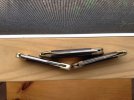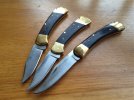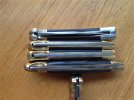View attachment 879724
View attachment 879725
The 112 above on the right is a three dot that came to me in really poor shape. The poor thing had a terrible action, was almost impossible to open and had to be forced closed. I asked here on the forum how to replace the pivot pin and a custom modder who sells a stuff on the bay walked me through the process. I think the knife may have been a tackle box knife. The blade has some deep pits but cleaned up nicely. This was the first Buck folder that I took apart, it was a learning experience, and when all cleaned up and re-pinned the pivot, the knife sprang back to life, literally. After that I decided to sand away all the deep dings in the bolsters and the spine. which left the knife quite a bit thinner, and also needing to be re-pinned at the pivot.
View attachment 879726
The 110 above came to me in a trade. It had a sloppy lockup and lazy action. It had been abused and flicked open by a previous owner, and had also been used as a hammer or some such, because the bolsters were heavily dinged, and the spine also, with chips missing from the scales. I sanded the bolsters past the dings while shaping them to be slimmer at the ends, leaving as much material as possible as I sanded the scales down past any chips and dings. this left a really pleasing contour to the knife, feeling very good in hand and also in the pocket. I removed the blade and replaced the spring, and re pinned the pivot and then re finished the bolsters. The lazy action was gone, and lockup is solid, and now this old 110 is as snappy as the day it was born. All done by hand, many hours were spent working on these knives to morph them into my own personal tools.
View attachment 879727
You can still see a few scars on the spine of the 110, to me they are just beauty marks, from it's former life, it is in better hands now, and gets lovingly carried and used from time to time...
I lost all my photo's in a computer crash, and from the Photo Bucket ransom, I had some pics of others I did, but they are just memories to me now...









